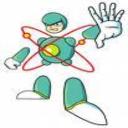1
answer
0
watching
561
views
23 Nov 2019
A mass m rests on a frictionless horizontal table and isconnected to rigid supports via 2 identical springs each of relaxedlength L0 and spring constantk. Each spring is stretched to a length L considerable greater thanL0. Horizontal displacementsof m from its equilibrium position are labeled x and y. (Diagram insert didn't work, all it really tells you is that xis on the axis of the springs and y is perpendicular to thesprings) a) Write down the differential equation of motion (i.e.,Newton's Law) governing small oscillations in the xdirection. b) Same as a but in the y direction (assume that y <<L). c) In terms of L and L0, calculate the ratio of the periods ofthe oscillations along x and y. d) If at t=0 the mass m is released from the point x = y = A0with zero velocity, what are its x and y coordinates at any latertime t? --------------------------- So, I started with just ma = -2kx for a, leading me to thedifferential equation x''(t) + (2k/m) x = 0. Then I did basically the same thing with y. However, when I get to c, there's my problem - I don't knowhow I could write any of this in L and L0. Also, b doesn't really make sense to me because if y is smallwhen compared to L, it seems like there shouldn't be anyoscillation in the y direction. The answer the back of the book shows for c and d are: c) Tx/Ty = (1 - L0 / L)1/2 d) x(t) = A0cos( (2k/m)1/2 t) y(t) = A0cos( (2k(L-L0)/mL)1/2 t) I have no idea how they got to these answers. Can somebodyhelp me? It has something to do with springs already beingstretched, but it seems they are making an assumption somewherethat I don't understand.
A mass m rests on a frictionless horizontal table and isconnected to rigid supports via 2 identical springs each of relaxedlength L0 and spring constantk. Each spring is stretched to a length L considerable greater thanL0. Horizontal displacementsof m from its equilibrium position are labeled x and y.
(Diagram insert didn't work, all it really tells you is that xis on the axis of the springs and y is perpendicular to thesprings)
a) Write down the differential equation of motion (i.e.,Newton's Law) governing small oscillations in the xdirection.
b) Same as a but in the y direction (assume that y <<L).
c) In terms of L and L0, calculate the ratio of the periods ofthe oscillations along x and y.
d) If at t=0 the mass m is released from the point x = y = A0with zero velocity, what are its x and y coordinates at any latertime t?
---------------------------
So, I started with just ma = -2kx for a, leading me to thedifferential equation x''(t) + (2k/m) x = 0.
Then I did basically the same thing with y.
However, when I get to c, there's my problem - I don't knowhow I could write any of this in L and L0.
Also, b doesn't really make sense to me because if y is smallwhen compared to L, it seems like there shouldn't be anyoscillation in the y direction.
The answer the back of the book shows for c and d are:
c) Tx/Ty = (1 - L0 / L)1/2
d) x(t) = A0cos( (2k/m)1/2 t)
y(t) = A0cos( (2k(L-L0)/mL)1/2 t)
I have no idea how they got to these answers. Can somebodyhelp me? It has something to do with springs already beingstretched, but it seems they are making an assumption somewherethat I don't understand.
Tod ThielLv2
14 Sep 2019





